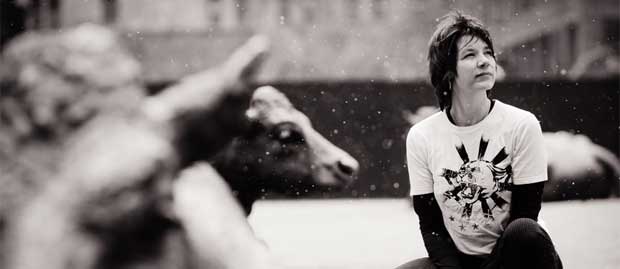In preparation for the special screening of The Ghosts In Our Machine in Vancouver on August 2, The Association for the Protection of Fur-Bearing Animals interviewed Ghosts producer/director/writer Liz Marshall.
Liz Marshall was looking for a story. The successful Canadian filmmaker, known for her projects focusing on social justice, had completed Water on the Table in 2010 to rave reviews and international awards. It was time for a new challenge.
“I was very drawn to the challenge of the subject matter,” Marshall said in an interview with The Association for the Protection of Fur-Bearing Animals. “Not knowing whether I would fail or succeed, I wanted to try to make a film and cross-media project that explored the issues of animals and sentient beings and animal use. The animal rights movement has largely been misunderstood and very marginalized. I wanted to try and create something that would be like a bridge to people in communities and movements that don’t give it the time or space that they should.”

“I think if we had tried to do this 10 years ago it would have been very different,” she explained. “It may not have been accepted at HotDOCS. It may not have been funded. I think we’re living in a culture that has a burgeoning movement to embrace a more ethical, compassionate consumer lifestyle.”
But great stories are not told by filmmakers; filmmakers capture on camera the great stories being lived by others.
“I was looking for a story,” Marshall recalled. “Not just an issue, but a story in which to ground it. I wanted to create a compelling narrative that people could follow that had a beginning, middle and an end.”
Marshall’s friend and neighbour, Jo-Anne McArthur, entered the Ghosts story then.
“I’d known Jo for a number of years,” Marshall said. “We live in the same part of town and we had kind of a kinship because we’ve both done a lot of world travel, me making films, she taking photographs. But over time, I became more and more interested in her images and found that they pose moral questions and don’t come across in a didactic way. That was an inspiration for me initially.”
But over time, Marshall recognized that things had – in her own words – clicked.
“She’s almost like a conduit,” Marshall said of McArthur. “Through her lens we access these stories. And it’s not just through her photographic lens; it’s through her perspective, her point of view, that we access those worlds. That felt correct to me.”
The Investigation
Perhaps the most dramatic moments of the film are those involving McArthur’s journey into a European fur farm. Though it was an upsetting case of business-as-usual for the photographer, it was a first for filmmaker Marshall.

The investigation did not show blood or guts. The intent of it was not to shock, though that is the reaction of many viewers.
“People find it harrowing,” Marshall said. “They’re just not familiar with those types of images. To put a face to your fur trim on your boot is shocking. We were very deliberate in the pacing of that scene – there is no music and it’s very non-manipulative. We hear the voices of the animals, we hear the sounds of nature in the background, we hear the clicking of the camera and we see close ups of the faces of these animals and we linger. All the way through the film, I wanted people to experience the animals by looking into their eyes, because that’s also what Jo-Anne does with her pictures.”
Throughout the film, there is no demand on viewers. There is no telling of what is right or wrong and no explanation of what is expected of them.
“There’s a word for it – it’s observational photography,” Marshall explained. “Even though it’s a point-of-view narrative from Jo-Anne, the way that it’s crafted is observational. We bear witness but do it in a way that people can figure out for themselves what’s going on there and how they feel about it. During the fur investigation there is no talking, there is no interview, there is no one telling us what we’re seeing. We’re just seeing it.”
A scene in the later part of the film shows Jo-Anne sitting in a cabin at a farm sanctuary in winter. She is dressed warmly in comfortable clothes, sitting at an old-fashioned desk and writing in descriptions to her photo book. It is simply serene.
“I wanted there to be an interior of peace,” Marshall said. “With the animals, and also with Jo. Her story and their stories are intertwined. At the heart of the movie is the sentience of these non-human animals, this whole cast of characters. But the connective thread is the sentience of Jo-Anne McArthur.”
Photo credits: (Top) Jo-Anne McArthur. (Right) James Heaslip.
JOIN US!
Ghosts In Our Machine
August 2, 3 & 7 & 8
Vancouver, BC
